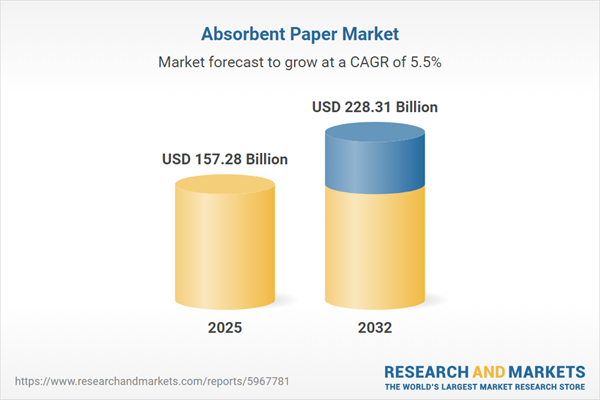Speak directly to the analyst to clarify any post sales queries you may have.
The absorbent paper market is experiencing a pivotal shift, shaped by regulatory adjustments, sustainability mandates, and advances in digitalization. Senior executives are balancing risk management with opportunities to lead in operational adaptation and long-term value creation for their organizations.
Market Snapshot: Absorbent Paper Market Outlook
The absorbent paper market is projected to grow from USD 148.94 billion in 2024 to USD 157.28 billion in 2025 and is forecast to reach USD 228.31 billion by 2032, registering a compound annual growth rate (CAGR) of 5.48%.
Rising urbanization and heightened hygiene standards—across commercial, industrial, and consumer verticals—are transforming procurement strategies. Companies are encountering tighter environmental policies, new stakeholder requirements, and greater calls for transparency throughout supply chains. Strategic investments in automation and digital process integration are reducing operational risk, building organizational resilience, and facilitating rapid adaptability in competitive global markets. Leaders adopting both technology and sustainability principles at scale are positioned to achieve durable competitive advantage as sector expectations evolve.Scope & Segmentation: Absorbent Paper Market
This report provides executive-level analysis and actionable insights into the absorbent paper sector, supporting resource allocation and strategic planning across segments, technologies, and geographic regions. The breakdown below equips decision-makers to assess specific market priorities and adjust operational or compliance strategies.
- Product Types: Includes cellulose-based and nonwoven industrial wipes, napkins for dining settings, kitchen towels, facial tissues, handkerchiefs, and toilet paper, each serving varied commercial and domestic needs.
- Applications: Ranges from hospitality, healthcare, and food service operations to industrial cleaning in automotive and food processing, as well as household care and ongoing facility maintenance.
- End Users: Spans automotive, manufacturing, healthcare, hospitality, education, food service, and residential sectors, all with distinct performance and regulatory requirements for absorbency and safety.
- Distribution Channels: Covers convenience outlets, specialty retailers, supermarkets, e-commerce marketplaces, hypermarkets, and wholesalers to support broad access for both B2B and B2C customers.
- Raw Materials: Incorporates both recycled fibers (deinked and mechanical grades) and virgin pulp, facilitating balance between emerging sustainability goals and rigorous end-use criteria.
- Packaging Types: Utilizes paper board, polyethylene films, and wrap rolls, optimizing logistics efficiency and fulfilling shelf-display and delivery requirements.
- Regions: Includes Americas, Europe, Middle East, Africa, and Asia-Pacific, with targeted assessment of leading markets such as the United States, Germany, China, India, and Brazil to highlight growth opportunities and map out regional investment priorities.
Absorbent Paper Market: Key Takeaways
- Procurement strategies increasingly center on recycled content and introduction of alternative fibers, aligning with environmental objectives and compliance demands from major stakeholders.
- Digital platforms across supply chains enable improved tracking, enhance supplier engagement, and support transparency, sustaining business continuity in dynamic markets.
- Demand is rising for antimicrobial and specialty absorbent products, driven by strict hygiene needs in commercial and public applications.
- Distinct regional approaches are emerging: North American firms emphasize regulatory compliance, while Asia-Pacific market participants leverage urban and industrial growth across the value chain.
- Innovative packaging is addressing evolving distribution workflows, supporting productive asset lifecycles and sustainable development criteria.
- Heightened ESG commitments are now central to sustaining stakeholder trust and demonstrating responsible leadership within the absorbent paper value chain.
Tariff Impact: Navigating New U.S. Trade Barriers
The recent introduction of U.S. tariffs on imported pulp and paper inputs has prompted market participants to seek more localized sourcing solutions and implement vertical integration. These moves are reinforcing supply chain stability, minimizing exposure to policy-related volatility, and ensuring service continuity—even under unpredictable global trading conditions.
Methodology & Data Sources
Findings are based on direct interviews with manufacturers, distributors, and end users active within the absorbent paper market. The analysis is further validated through established industry reports and official regulatory resources, providing credible and actionable intelligence for senior leaders.
Why This Report Matters
- Empowers organizations to refine supply chain and product strategies, minimizing disruption and maximizing performance amid regulatory and industry change.
- Clarifies new market development opportunities in established and emerging regions, guiding executive resource allocation and growth planning.
- Links technology innovation with responsible sourcing practices, helping leaders anticipate change and proactively manage operational risk.
Conclusion
As digitalization, regulatory attention, and sustainability standards reshape sector priorities, executives who champion transformation position their organizations for resilient growth and lasting stakeholder value in the absorbent paper industry.
Additional Product Information:
- Purchase of this report includes 1 year online access with quarterly updates.
- This report can be updated on request. Please contact our Customer Experience team using the Ask a Question widget on our website.
Table of Contents
3. Executive Summary
4. Market Overview
7. Cumulative Impact of Artificial Intelligence 2025
Companies Mentioned
The companies profiled in this Absorbent Paper market report include:- Essity Aktiebolag
- Kimberly-Clark Corporation
- The Procter & Gamble Company
- Georgia-Pacific LLC
- Sofidel S.p.A
- Asia Pulp & Paper Co., Ltd
- Oji Holdings Corporation
- Nippon Paper Industries Co., Ltd
- Clearwater Paper Corporation
- Cascades Inc.
Table Information
| Report Attribute | Details |
|---|---|
| No. of Pages | 181 |
| Published | November 2025 |
| Forecast Period | 2025 - 2032 |
| Estimated Market Value ( USD | $ 157.28 Billion |
| Forecasted Market Value ( USD | $ 228.31 Billion |
| Compound Annual Growth Rate | 5.4% |
| Regions Covered | Global |
| No. of Companies Mentioned | 11 |









